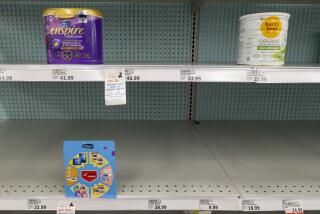It’s the Next Best Thing to Mother’s Milk
- Share via
Few pediatricians and parents would dispute that breast milk is the best source of nutrients for infants during the first year of life. But for a variety of reasons, many women choose not to breastfeed, and for some women breastfeeding is not an option. Fortunately, there is a safe alternative: infant formula.
Formula is designed to mimic, as much as possible, the composition of breast milk, and to provide an adequate balance of energy and nutrients. A number of formulas are available--to choose the right one, it’s important to understand the differences.
Although the majority of formula sold in the United States is derived from cow’s milk, the sale of soy formula (which is made from soybeans) has nearly doubled in the last decade or so. (Currently, about 25% of formula-fed infants are given soy-based formula.)
The most significant difference between cow’s milk and soy formulas is the types of proteins and carbohydrates they contain. The proteins of each are modified considerably to make them more digestible for babies. The principal carbohydrate in cow’s milk formula is lactose. Soy formula, on the other hand, contains carbohydrates such as sucrose and is lactose-free.
For most infants, either type of formula is fine. Although high levels of aluminum and hormonally active compounds (called soy isoflavones, or phytoestrogens) in soy formula have worried some doctors, recent research has found the formula to be safe. Experts now believe that for healthy, full-term infants, soy-based formula is a safe alternative to cow’s milk formula. They do not think that it offers significant advantages for most infants; for example, it appears to have no benefit over cow’s milk formula in the prevention of allergic disease.
But soy formula is better for infants who can’t tolerate the lactose in cow’s milk or who are allergic to cow’s milk protein. These conditions are relatively rare, however--a true milk protein allergy occurs in only about 2% to 3% of infants. Soy formula is also indicated for children whose parents want them to consume a vegetarian diet.
A third type of formula, hypoallergenic formula, contains proteins that are more extensively broken down than in cow’s milk or soy formula and are less likely to cause allergic reactions. It is principally used for breastfeeding infants who develop symptoms of food allergy and for formula-fed infants allergic to both cow’s milk and soy formulas. Hypoallergenic formula is significantly more expensive than other types and should only be used on the advice of a physician.
For those who choose to use a cow’s milk formula, an additional decision is necessary: to fortify with iron or not. (All soy-based formula is iron-fortified.) Infant formulas are classified as low-iron or iron-fortified based on whether they contain less or more than 6.7 milligrams per liter of iron.
The goal of iron fortification is not only to meet children’s need for this important nutrient, but to protect them against the later development of anemia. Iron-fortified formula is recommended by the American Academy of Pediatrics for all bottle-fed infants from birth to 1 year of age and for all breastfed infants whose mothers do not exclusively breastfeed.
Despite these recommendations, low-iron formula accounts for up to 30% of all the formula sold in the United States. Some parents opt for it because they mistakenly believe that formula with added iron causes gastrointestinal problems like constipation, diarrhea or colic. Other parents are unsure what to make of the “with iron” label that fortified formula is required to carry. (Some experts suggest removing this label from fortified formula and instead labeling low-iron formula as “nutritionally incomplete.”)
Regardless of the type of formula used, prepare it exactly as directed on the packaging. With powdered or concentrated formula, do not add more water than necessary. Diluted formula won’t provide enough calories and nutrients, and can potentially cause seizures. (And, despite what some parents believe, it’s not the answer to spitting up or gastrointestinal problems like diarrhea or constipation.)
Although most experts advocate using sterilized water to prepare infant formula, there is some controversy about whether it’s necessary when water from a public water system is available.
Water from a public source is treated to reduce the amount of harmful bacteria and is unlikely to cause illness, even in infants. But, because bacteria or other infectious organisms--like parasites--can occasionally reach dangerous levels, sterilizing the water used in formula is probably a good precaution. (To sterilize water, bring it to a full boil for one to two minutes, allowing it to cool completely before serving it.)
Store any formula prepared in advance in the refrigerator. Once formula is prepared (or, in the case of ready-to-use formula, the vacuum seal is broken), bacteria can start to grow and multiply in it. Storing it at a cold temperature slows--but does not stop--the rate of bacterial growth. If prepared formula isn’t used within 24 hours, throw it away.
Finally, don’t substitute cow’s milk for formula before age 1. Formula is specially designed to meet the nutritional needs of infants during this critical period of growth and development; cow’s milk is not. Although it’s not breast milk, formula is the next best thing for a baby’s first year.
*
Dr. Jonathan Fielding is the director of public health and the health officer for the Los Angeles County Department of Health Services. Dr. Valerie Ulene is a board-certified specialist in preventive medicine practicing in Los Angeles. Their column appears the second and fourth Mondays of the month. Send questions by e-mail to ourhealth@dhs.co.la.ca.us. They cannot respond to every query.






